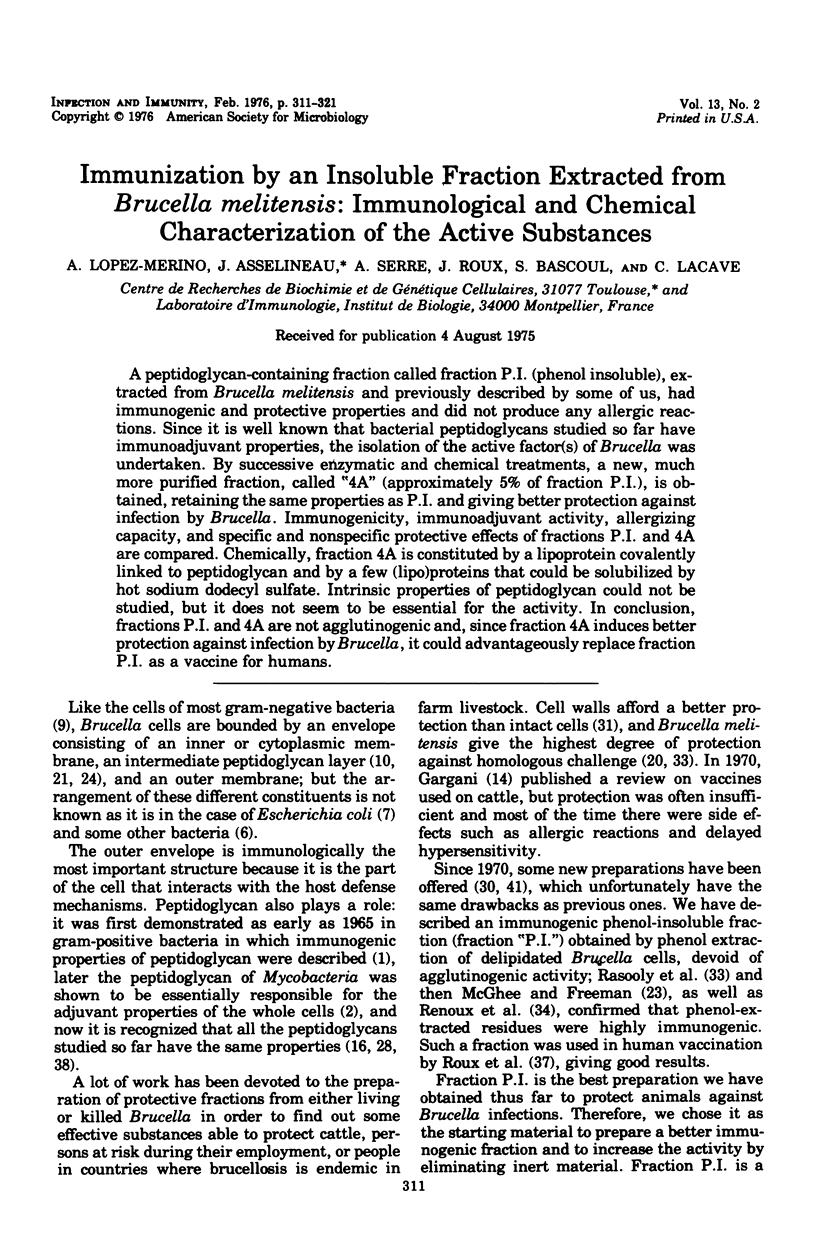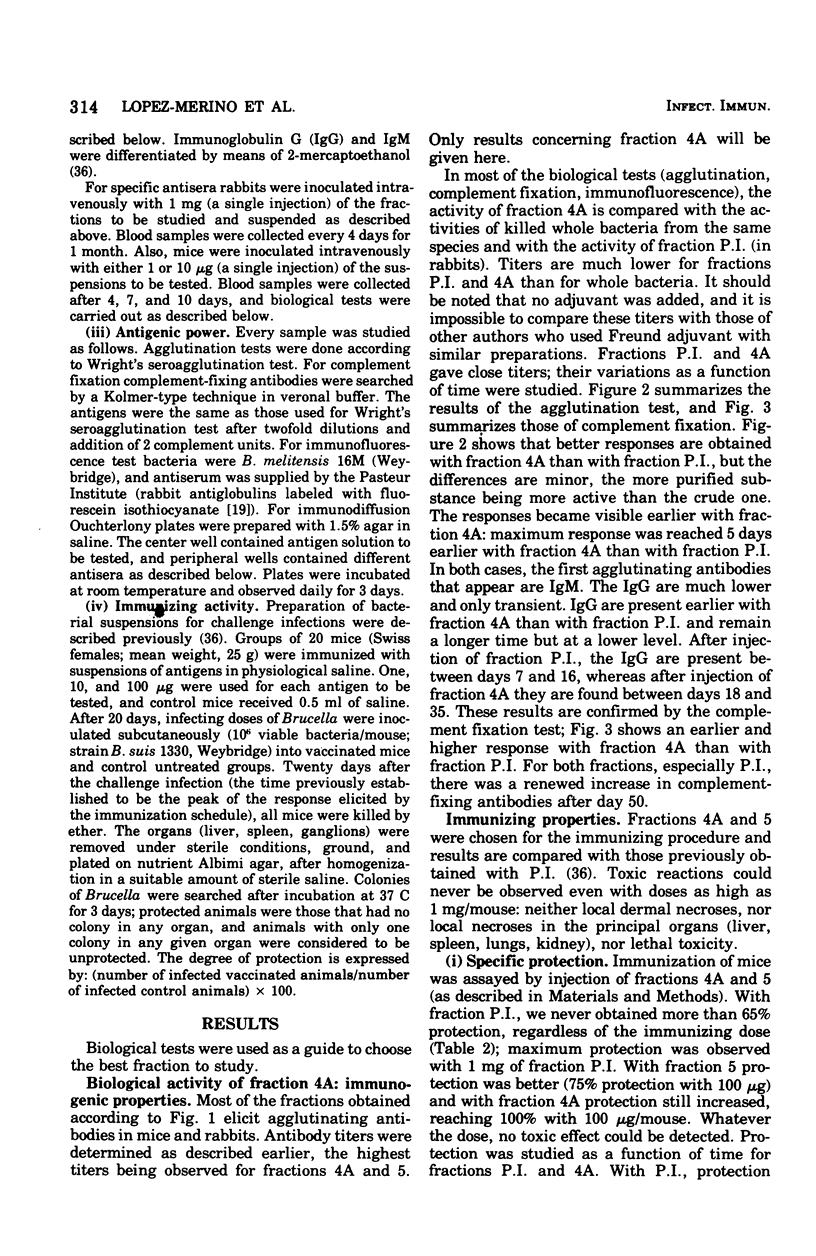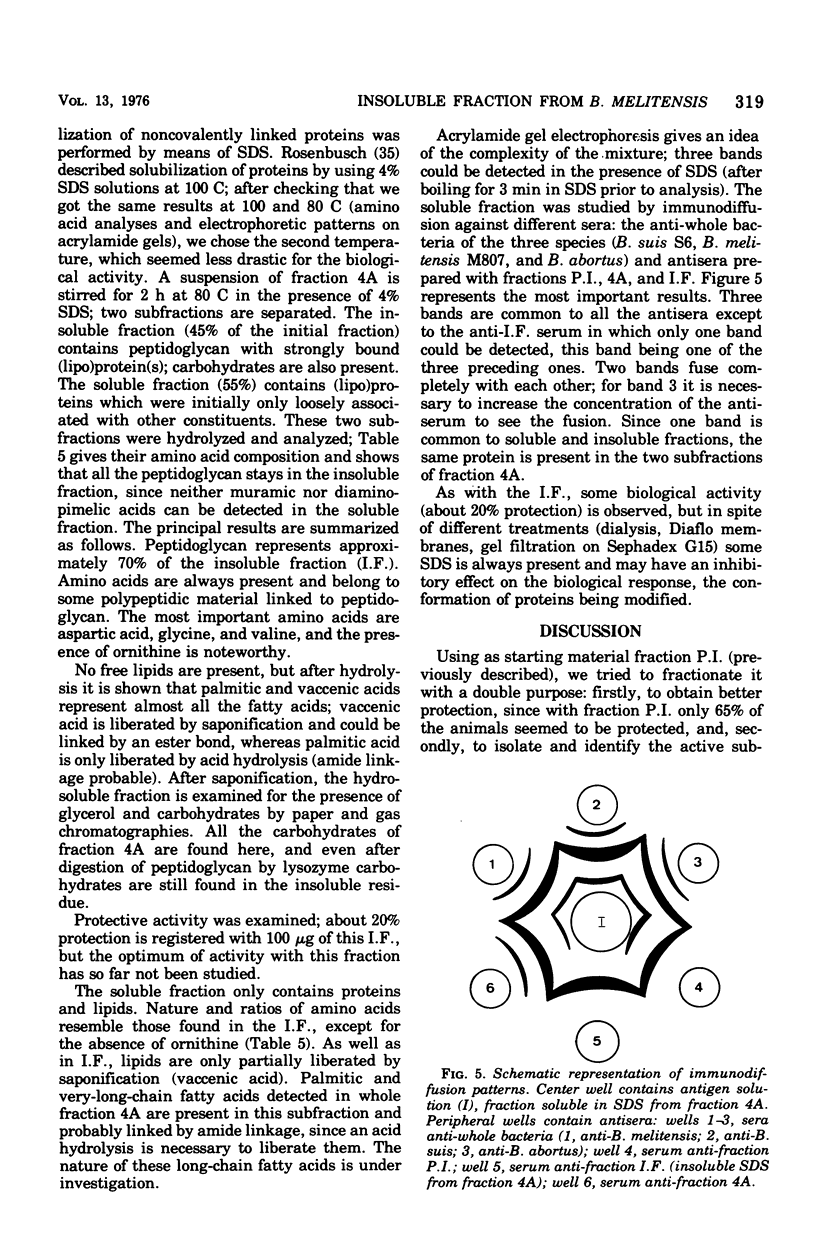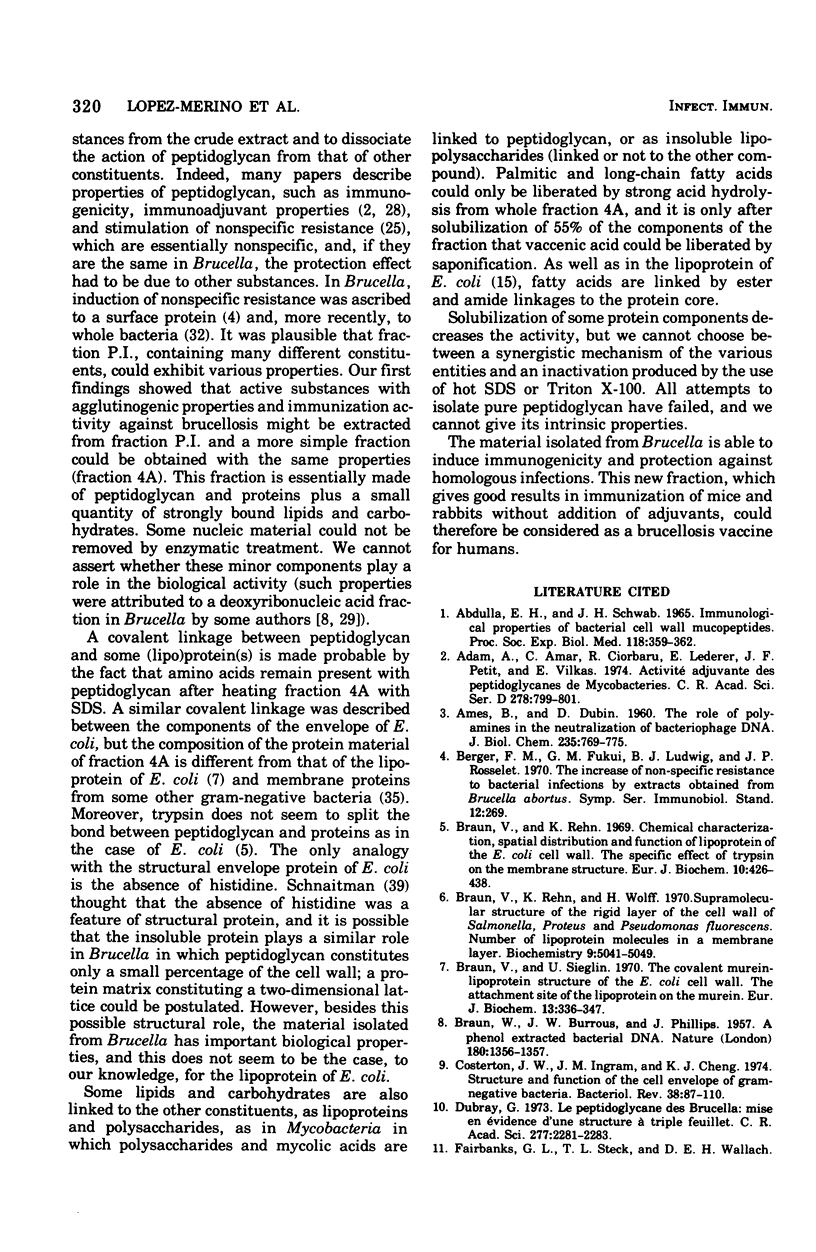Abstract
A peptidoglycan-containing fraction called fraction P.I. (phenol insoluble), extracted from Brucella melitensis and previously described by some of us, had immunogenic and protective properties and did not produce any allergic reactions. Since it is well known that bacterial peptidoglycans studied so far have immunoadjuvant properties, the isolation of the active factor(s) of Brucella was undertaken. By successive enzymatic and chemical treatments, a new, much more purified fraction, called "4A" (approximately 5% of fraction P.I.), is obtained, retaining the same properties as P.I. and giving better protection against infection by Brucella. Immunogenicity, immunoadjuvant activity, allergizing capacity, and specific and nonspecific protective effects of fractions P.I. and 4A are compared. Chemically, fraction 4A is constituted by a lipoprotein covalently linked to peptidoglycan and by a few (lipo)proteins that could be solubilized by hot sodium dodecyl sulfate. Intrinsic properties of peptidoglycan could not be studied, but it does not seem to be essential for the activity. In conclusion, fractions P.I. and 4A are not agglutinogenic and, since fraction 4A induces better protection against infection by Brucella, it could advantageously replace fraction P.I. as a vaccine for humans.
Full text
PDF










Selected References
These references are in PubMed. This may not be the complete list of references from this article.
- ABDULLA E. M., SCHWAB J. H. IMMUNOLOGICAL PROPERTIES OF BACTERIAL CELL WALL MUCOPEPTIDES. Proc Soc Exp Biol Med. 1965 Feb;118:359–362. doi: 10.3181/00379727-118-29842. [DOI] [PubMed] [Google Scholar]
- AMES B. N., DUBIN D. T. The role of polyamines in the neutralization of bacteriophage deoxyribonucleic acid. J Biol Chem. 1960 Mar;235:769–775. [PubMed] [Google Scholar]
- Adam A., Amar C., Ciorbaru R., Lederer E., Petit J. F., Vilkas E. Activité adjuvante des peptidolycanes de mycobacteries. C R Acad Sci Hebd Seances Acad Sci D. 1974 Feb 4;278(6):799–801. [PubMed] [Google Scholar]
- BRAUN W., BURROUS J. W., PHILLIPS J. H., Jr A phenol-extracted bacterial deoxyribonucleic acid. Nature. 1957 Dec 14;180(4598):1356–1357. doi: 10.1038/1801356a0. [DOI] [PubMed] [Google Scholar]
- Braun V., Rehn K. Chemical characterization, spatial distribution and function of a lipoprotein (murein-lipoprotein) of the E. coli cell wall. The specific effect of trypsin on the membrane structure. Eur J Biochem. 1969 Oct;10(3):426–438. doi: 10.1111/j.1432-1033.1969.tb00707.x. [DOI] [PubMed] [Google Scholar]
- Braun V., Rehn K., Wolff H. Supramolecular structure of the rigid layer of the cell wall of Salmonella, Serratia, Proteus, and Pseudomonas fluorescens. Number of lipoprotein molecules in a membrane layer. Biochemistry. 1970 Dec 22;9(26):5041–5049. doi: 10.1021/bi00828a001. [DOI] [PubMed] [Google Scholar]
- Braun V., Sieglin U. The covalent murein-lipoprotein structure of the Escherichia coli cell wall. The attachment site of the lipoprotein on the murein. Eur J Biochem. 1970 Apr;13(2):336–346. doi: 10.1111/j.1432-1033.1970.tb00936.x. [DOI] [PubMed] [Google Scholar]
- Costerton J. W., Ingram J. M., Cheng K. J. Structure and function of the cell envelope of gram-negative bacteria. Bacteriol Rev. 1974 Mar;38(1):87–110. doi: 10.1128/br.38.1.87-110.1974. [DOI] [PMC free article] [PubMed] [Google Scholar]
- Fauve R. M., Hevin M. B. Pouvoir bactéricide des macrophages spléniques et hépatiques de souris envers Listeria monocytogenes. Influence du traitement préalable des animaux par des glucocorticoides, une endotoxine, Corynebacterium parvum et l'acide polyinosinique, polycytidylique (Poly: I.C.) Ann Inst Pasteur (Paris) 1971 Mar;120(3):399–411. [PubMed] [Google Scholar]
- Garbit F., Hermier B., Dubert J. M. Propriétés antigéniques et immunogénes de sous-unités protéiques obtenues par l'action du dodecyl sulfate de sodium. Biochimie. 1974;56(2):289–295. doi: 10.1016/s0300-9084(74)80389-5. [DOI] [PubMed] [Google Scholar]
- Hantke K., Braun V. Covalent binding of lipid to protein. Diglyceride and amide-linked fatty acid at the N-terminal end of the murein-lipoprotein of the Escherichia coli outer membrane. Eur J Biochem. 1973 Apr;34(2):284–296. doi: 10.1111/j.1432-1033.1973.tb02757.x. [DOI] [PubMed] [Google Scholar]
- Helgeland S., Grov A., Schleifer K. H. The immunochemistry of Staphylococcus aureus mucopeptide. I. Antigenic specificity of the peptide subunits. Acta Pathol Microbiol Scand B Microbiol Immunol. 1973 Aug;81(4):413–418. doi: 10.1111/j.1699-0463.1973.tb02224.x. [DOI] [PubMed] [Google Scholar]
- Hirashima A., Wu H. C., Venkateswaran P. S., Inouye M. Two forms of a structural lipoprotein in the envelope of Escherichia coli. Further characterization of the free form. J Biol Chem. 1973 Aug 25;248(16):5654–5659. [PubMed] [Google Scholar]
- Keppie J., Witt K., Smith H. The immunization of guinea-pigs and mice with a whole-culture extract of a smooth and a rough strain of Brucella abortus. Br J Exp Pathol. 1972 Oct;53(5):518–528. [PMC free article] [PubMed] [Google Scholar]
- LACAVE C., ROUX J. COMPOSITION CHIMIQUE DES PAROIS DE BRUCELLA. GLYCOSAMINOPEPTIDE DE BRUCELLA ABORTUS ET BRUCELLA MELITENSIS. C R Hebd Seances Acad Sci. 1965 Feb 1;260:1514–1517. [PubMed] [Google Scholar]
- LOWRY O. H., ROSEBROUGH N. J., FARR A. L., RANDALL R. J. Protein measurement with the Folin phenol reagent. J Biol Chem. 1951 Nov;193(1):265–275. [PubMed] [Google Scholar]
- McGhee J. R., Freeman B. A. Fractionation of Phenol Extracts from Brucella suis: Separation of Multiple Biologically Active Components. Infect Immun. 1970 Sep;2(3):244–249. doi: 10.1128/iai.2.3.244-249.1970. [DOI] [PMC free article] [PubMed] [Google Scholar]
- Misaki A., Yukawa S., Tsuchiya K., Yamasaki T. Studies on cell walls of Mycobacteria. I. Chemical and biological properties of the cell walls and the mucopeptide of BCG. J Biochem. 1966 Apr;59(4):388–396. doi: 10.1093/oxfordjournals.jbchem.a128314. [DOI] [PubMed] [Google Scholar]
- Mizushima S. Effect of sodium dodecylsulfate and heating on protein conformation in outer and cytoplasmic membranes from Escherichia coli. Biochem Biophys Res Commun. 1974 Dec 23;61(4):1221–1226. doi: 10.1016/s0006-291x(74)80414-6. [DOI] [PubMed] [Google Scholar]
- Munro H. N. The determination of nucleic acids. Methods Biochem Anal. 1966;14:113–176. doi: 10.1002/9780470110324.ch5. [DOI] [PubMed] [Google Scholar]
- Nauciel C., Fleck J., Martin J. P., Mock M. Activité adjuvante de piptidoglycanes de bactéries à Gram négatif dans l'hypersensibilité de type retardé. C R Acad Sci Hebd Seances Acad Sci D. 1973 Jun 25;276(26):3499–3500. [PubMed] [Google Scholar]
- PHILLIPS J. H., BRAUN W., PLESCIA O. J. Antigenicity of a bacterial deoxyribonucleic acid. Nature. 1958 Feb 22;181(4608):573–575. doi: 10.1038/181573a0. [DOI] [PubMed] [Google Scholar]
- Rasooly G., Boros D. L., Gerichter C. Immunization against Brucella with killed baccines. 3. Experiments in mice. Isr J Med Sci. 1968 Mar-Apr;4(2):246–251. [PubMed] [Google Scholar]
- Renoux G., Renoux M., Tinelli R. Phenol-water fractions from smooth Brucella abortus and Brucella melitensis: immunochemical analysis and biologic behavior. J Infect Dis. 1973 Feb;127(2):139–148. doi: 10.1093/infdis/127.2.139. [DOI] [PubMed] [Google Scholar]
- Rosenbusch J. P. Characterization of the major envelope protein from Escherichia coli. Regular arrangement on the peptidoglycan and unusual dodecyl sulfate binding. J Biol Chem. 1974 Dec 25;249(24):8019–8029. [PubMed] [Google Scholar]
- Roux J., Asselineau J., Serre A., Lacave C. Propriétés immunologiques d'un extrait phénol-insoluble de Brucella melitensis (fraction P.I.) Ann Inst Pasteur (Paris) 1967 Sep;113(3):411–423. [PubMed] [Google Scholar]
- Roux J., Serre A., Asselineau J., Lacave C. La vaccination humaine antibrucellique par une fraction antigénique de Brucella melitensis. Bull Acad Natl Med. 1970 Apr-May;154(15):318–322. [PubMed] [Google Scholar]
- Schleifer K. H., Krause R. M. The immunochemistry of peptidoglycan. I. The immunodominant site of the peptide subunit and the contribution of each of the amino acids to the binding properties of the peptides. J Biol Chem. 1971 Feb 25;246(4):986–993. [PubMed] [Google Scholar]
- Schnaitman C. A. Comparison of the envelope protein compositions of several gram-negative bacteria. J Bacteriol. 1970 Dec;104(3):1404–1405. doi: 10.1128/jb.104.3.1404-1405.1970. [DOI] [PMC free article] [PubMed] [Google Scholar]
- Schnaitman C. A. Effect of ethylenediaminetetraacetic acid, Triton X-100, and lysozyme on the morphology and chemical composition of isolate cell walls of Escherichia coli. J Bacteriol. 1971 Oct;108(1):553–563. doi: 10.1128/jb.108.1.553-563.1971. [DOI] [PMC free article] [PubMed] [Google Scholar]
- Sterne M., Trim G., Broughton E. S. Immunisation of laboratory animals and cattle with non-agglutinogenic extracts of Brucella abortus strain 45-20. J Med Microbiol. 1971 May;4(2):185–194. doi: 10.1099/00222615-4-2-185. [DOI] [PubMed] [Google Scholar]
- Wietzerbin J., Lederer F., Petit J. F. Structural study of the poly-l-Glutamic acid of the cell wall of Mycobacterium tuberculosis var hominis, strain Brevannes. Biochem Biophys Res Commun. 1975 Jan 20;62(2):246–252. doi: 10.1016/s0006-291x(75)80130-6. [DOI] [PubMed] [Google Scholar]


